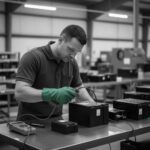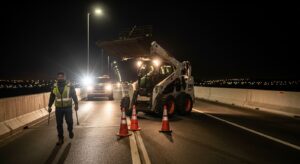Working construction at night brings a whole new set of challenges—poor visibility being one of the biggest. When daylight fades, shadows grow deeper, and the risks increase. Workers face hazards from moving machinery, traffic, and even missteps on uneven terrain. That’s why nighttime safety planning isn’t optional—it’s essential. With the right measures, you can protect everyone on-site and keep productivity high without sacrificing safety.

Lighting: Your First Line of Defense
Good lighting is the foundation of nighttime worksite safety. Without it, hazards can hide in plain sight. Even a familiar workspace can become dangerous in the dark—trip hazards are harder to spot, hand signals can be missed, and machine operators can lose sight of nearby workers.
Key steps for effective lighting:
Assess Lighting Needs – Walk the site before work begins and identify dark zones, shadowed corners, and high-traffic areas. Different tasks require different lighting intensity. For example, precision tasks like wiring may need brighter, more focused light than general site navigation.
Use the Right Equipment – Combine portable light towers for large-scale coverage, floodlights for high-intensity zones, and personal headlamps so each worker carries their own beam of light. This layered approach helps reduce blind spots.
Maintain Lighting Equipment – Burnt-out bulbs or misaligned fixtures can create dangerous “dark holes” on the job. Make inspections part of your daily safety checklist, replacing faulty gear immediately. A light that’s out isn’t just inconvenient—it’s a hazard.
High-Visibility Gear: Be Seen, Stay Safe
Lighting helps you see your environment. High-visibility (hi-vis) gear ensures others can see you. Reflective strips on vests, helmets, and armbands catch and bounce light from vehicles, machinery, or even fellow workers’ headlamps. This visibility is crucial when noise makes verbal warnings harder to hear.
Best practices for hi-vis gear:
Wear Class 2 or Class 3 reflective vests for work near traffic, depending on speed limits and traffic volume.
Ensure reflective material is clean—dust, mud, or wear can reduce its effectiveness.
Combine reflective gear with bright base colors like neon yellow or orange for added daytime visibility during shift changes.
Traffic Control: Staying Safe Near Roadways
If your construction site borders an active roadway, you’re dealing with two job sites at once: the work zone and the traffic zone. Drivers may be drowsy, distracted, or unprepared for lane changes, making it critical to guide them safely past the work area.
Core traffic safety measures:
Post Clear Signage – Use reflective, easy-to-read signs placed far enough ahead to give drivers time to react. Signs should be positioned to avoid glare that makes them unreadable at night.
Use Barriers and Cones – These physical boundaries keep vehicles where they belong and provide a clear separation between traffic and workers. Cones should be reflective and spaced to channel vehicles smoothly past the work zone.
Assign Trained Flaggers – Flaggers act as the “eyes and hands” of traffic control. They direct vehicles, communicate with drivers, and signal to workers when it’s safe to proceed. Proper training ensures flaggers know the safest positions to stand and how to manage traffic under pressure.
Training: Knowledge is Protection
Safety equipment is only effective when paired with safety knowledge. Workers must understand the specific risks that come with working after dark and know exactly how to respond if something goes wrong.
Essential training areas include:
Recognizing Nighttime Hazards – From reduced depth perception to increased fatigue, nighttime work changes the body’s response times and awareness. Training should include strategies to stay alert, such as scheduled breaks and hydration.
Operating Equipment in the Dark – Machinery operators need to know how to adjust mirrors, use built-in lights effectively, and rely on spotters when visibility is limited.
Emergency Response – In the event of an accident, every second counts. Workers should know the location of first aid kits, emergency exits, and communication devices, as well as the procedure for calling emergency services.
For those looking to deepen their knowledge, our updated EM-385 Course covers safety standards, hazard recognition, and best practices for nighttime construction. [Register here.]
Safety in Action: A Real-World Lesson
A crew working on a bridge resurfacing project learned firsthand how critical visibility is. It was just after midnight when a piece of equipment stalled on the far side of the bridge. A worker named Carlos grabbed a wrench and started across the deck to assist.
Unfortunately, the area between the light towers was dim, and Carlos’s reflective vest was partially covered by a jacket. A skid-steer operator, focused on maneuvering around cones, didn’t see him until the last moment. The machine stopped just feet away.
No one was hurt, but the incident sparked immediate changes. The crew repositioned lighting towers to eliminate the shadowed zone, ensured all jackets had reflective panels, and made it mandatory to wear personal headlamps. The near miss became a lasting reminder: safety gaps—no matter how small—can have serious consequences at night.
Final Thoughts
Working at night doesn’t have to mean working in danger. By prioritizing proper lighting, ensuring high-visibility gear is worn at all times, maintaining clear traffic control, and committing to ongoing training, you can create a safer, more efficient work environment. A little preparation before each shift can prevent major incidents later—and help make sure every worker goes home safe.
FAQs
1. What’s the best type of lighting for nighttime construction?
A mix of portable light towers for overall coverage, floodlights for concentrated work areas, and personal headlamps for mobility ensures the site is well-lit from multiple angles.
2. Why is high-visibility clothing important for night work?
It allows workers to stand out against the dark background, making them easier for both coworkers and machine operators to see, which reduces the chance of collisions.
3. How do traffic control measures improve safety?
By clearly marking work zones, directing drivers with trained flaggers, and using physical barriers, you minimize the risk of vehicles straying into active work areas.














